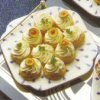LAMB RECIPES

Lamb can be rather a 'fatty' meat but nonetheless has a wonderful flavour and is less expensive than some other meats. It can be bought 'on the bone' as, for example, a leg or shoulder of lamb in which case it needs to be carved before serving. Alternatively, you can buy separate cuts like lamb chops that can be cooked individually in different ways.
When buying lamb you will want to know how to distinguish the quality and category and also how to prepare and cook lamb. You may also find the information about various Cuts Of Lamb helpful..
QUALITY
It is the breed, the age, the sex and the way in which the sheep have been fed that determines the flavour and tenderness of the meat. The best and most highly priced are the 'near salt' sheep that graze on coastal pastures rich in aromatic herbs and profiting from the iodised air.
Lamb of good quality has large kidneys, bright red, shiny flesh with a closely woven texture, short round legs and white or light yellow fat. Reject any animal where the legs are long and the fat yellow. Generally, this type of meat is from old 'mutton' and has a strong fatty taste and smell.
CATEGORY
There are three distinct Categories...
Pieces for grilling (or barbeque) or pieces for roasting or lower quality pieces that are best used in stews. For example...
Leg: As the name suggests, the top of the sheep's leg. Excellent for roasting.
Fillet: Sold either in its entirety or as cutlets (chops). Taken from the rear of the back and perfect for grilling when cut or roasting if used whole.
Saddle: The rear end of the animal that can be roasted whole or sliced and grilled.
Shoulder: Excellent for roasting but is difficult to carve neatly around the bone.
Collar: As the name suggests, this cut comes from around the animal's neck. It can be rather bony, but is fine when used in stews
Breast: Quite fatty and bony, but very tasy and excellent for a hot winter stew
PREPARATION AND COOKING
Generally, there is little to do when grilling or roasting joints since most butchers or food stores sell their lamb ready-prepared. For stewing cuts, you may have to trim off some of the fat. Usually it's simply a case of following whatever recipe you have chosen.
The main methods of cooking are:
ROASTING (Suitable for large cuts of meat)
The joint is placed in a roasting tin in a hot oven for a few minutes to seal in the juices. The heat is then reduced and the meat allowed to cook more slowly. The recognised cooking time at Mk 5 - 375ºF - 190ºC as about 15 minutes per pound (500g) weight. If you prefer your meat a little more cooked, you can add a few minutes to this.
BRAISING (Suitable for 'lower quality' cuts)
Braising is to cook gently and slowly in a greased or buttered pan or casserole dish with the lid on, either in the oven or on the hob. Because it is a slow process, it will tenderise even the poorest cuts.
GRILLING or BROILING (Suitable for smaller cuts like chops)
Grilling is the simplest, quickest and most efficient method of cooking a lamb chop. You can also pan fry them (as I often do).
STEWS and HOT POTS (Suitable for 'lower quality' and minced lamb)
Stews are an inexpensive way of eating any type of meat since cheaper cuts can be used.
What To Eat Tonight

55 Cocktail Parties & Finger Buffets
No need to scratch your head and wonder how to cater for that cocktail party or finger buffet. Just check out our great selection

76 Easy Beef Dinners
Beef and Veal are so versatile, yet can be easily spoiled by using the wrong recipe. We offer you lots of really delicious options.

179 Recipes for Kids
If you know what kids like, they're easy to please, even using 'healthy' foods that they normally avoid. It's all in the preparation!





























































